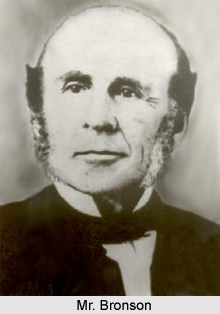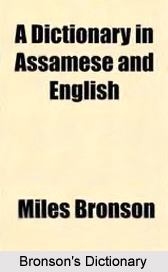 Influence of Europe on Assamese literature plated the colonial and post colonial hangover. The Ahoms ruled in Assam as the thirteenth century unfurled in the middle of the nineteenth century. Tempted by the wealth of the country they decided to conquer it. History has been a silent witness to the fact that whenever colonial imperialism takes place the conquered and the conquerors amalgamate to enrich and add to the sustaining language, literature and socio political sectors of the conquered land. 1826 witnessed the arrival of the Burmese and their engaging into a tumultuous conflict with the British in Cachar and, being defeated, their surrendering Assam to the British East India Company.
Influence of Europe on Assamese literature plated the colonial and post colonial hangover. The Ahoms ruled in Assam as the thirteenth century unfurled in the middle of the nineteenth century. Tempted by the wealth of the country they decided to conquer it. History has been a silent witness to the fact that whenever colonial imperialism takes place the conquered and the conquerors amalgamate to enrich and add to the sustaining language, literature and socio political sectors of the conquered land. 1826 witnessed the arrival of the Burmese and their engaging into a tumultuous conflict with the British in Cachar and, being defeated, their surrendering Assam to the British East India Company.
The British were strangers to the land and had no knowledge of the local tongue and as a result from other provinces of India they began to pour into Assam and settle down as interpreters and clerks of the British to enable them to carry on the newly established administration.
Early Age of European Influence
Mr. Bronson`s Dictionary was published in the year 1867 in Assamese and English from the Baptist Mission Press at Sibsagar first published Assamese Dictionary
Of the missionaries, Brown was the greatest single benefactor of Assamese literature. Together with O. Cutter, he established the first printing press in Assam in 1836, and from this press was published in 1844 the first newspaper in Assamese- Arunoday (The Sunrise). Reference has already been made to his Grammar of the Assamese Language. Another contribution of Brown was his Assamese version of the New Testament Written in an artificial and defective idiom by men with imperfect knowledge of Assamese, and dealing with an absolutely different set of saints, apostles and religious beliefs, the New Testament could not strike root in the minds of the common people who found in it nothing to approach the immortal epics, Ramayana and Mahabharata. In addition to the Christian tracts and psalms, which he composed and published, Brown also arranged for the publication of some old Assamese manuscripts.
 Evolution of Translation works as a result of European Influence
Evolution of Translation works as a result of European Influence
Among the local talents who assisted the missionaries, Nidhi Levi Farwell`s name is noteworthy. He published a number of articles and poems in the Arunoday and tried to standardise Assamese spelling and grammar. He also translated from Bengali in 1855 Natural Science in Familiar Dialogue. The book explains, in fourteen different dialogues, such phenomena as planetary motion, the atmosphere, the origin and mystery of man, the evolution of animals, plants, creepers and minerals. The book illustrates the earliest prose dialogue of modern Assamese, which was developed in the later prose dramas Mention may also be made of Yatrikarar Yatra (Assamese rendering of The Pilgrim`s Progress) and the novels Kamini Kanta and Phulmani Aru Karuna, which the missionaries published. Though scriptural in tone, Kamini Kanta by G. S. Gurney (1877) is the first modern Assamese novel. The missionaries wrote several books, all in prose, for the spread of Christianity. Though most of these books were translations from English and as a result lacked originality a different prose style capable of expressing varied interests evolved. The missionaries adopted in their compositions the spoken language of the people. They had no extensive or intimate knowledge of the genius of the language. The result was that their writings were artificial and sometimes even amusing for their malapropisms. On the whole their writings failed to attract the people.
The missionaries definitely achieved one thing. Up till now Assamese literature was more or less an oral literature confined to the villages and the Ahom court. The old religious tone was replaced by a more secular one, and there grew up a literature dealing not with a mythical world of gods and nymphs but with the life and society of the `mortal millions` here and now. Western ideas began to spread along with the progress of English education in the land. In every town a literary society was born. Old beliefs, ways and concepts yielded place to new ones. The influence of western ideas began to be keenly felt in the domain of literature, which now enters a period of varied creative activity. To this spread of new ideas, the widening of horizons and enrichment of literature, the press and the newspapers made an invaluable contributions, particularly the Baptist Mission Press of Shibsagar and its periodical, the Arunoday.
Change in the style of Poetry as a result of European Influence
As a result of the spread of the western system of education and the consequent impact of western ideas on the minds of the people, Assamese poetry underwent radical changes in both form and content. Assamese literature was influenced by the Romantic Revival in England, and the result was a new and unprecedented florescence of Assamese literature, rich and varied, vital and vigorous. The old and narrow outlook yielded place to catholicity, formalism to a variety of attractive and new patterns. There were innovations in diction, rhythm and imagery, potent instruments of poetic consciousness, and what emerged from these innovations was something novel, invigorating, powerful and brilliant. Assamese poetry entered into a romantic period of large and lofty dreams of Utopias and El Dorados, daring hopes and sky scraping aspirations. The new poetry sang of freedom for all from political dependence, social injustice, religious bigotry, of the dignity of the individual, and of the unity of the nation.
In Assamese, as in other languages, poetry was the earliest medium of expression. No wonder, therefore, that the new spirit of romanticism also found its earliest articulation in verse. This is pre-eminently true of modern Assamese poetry over which the influence of the English Romantic Revival was doubtless very wholesome. Its love of beauty developed in the Assamese poets a fuller appreciation of the scenic grandeur of their country. Similarly, its interest in antiquity imbued the Assamese poets with a deeper understanding and a more intense love of the national heritage.
Influence of Europe on Assamese language marked the essence of a new era. The after effect had been what one delineates as the alchemist touch.



















